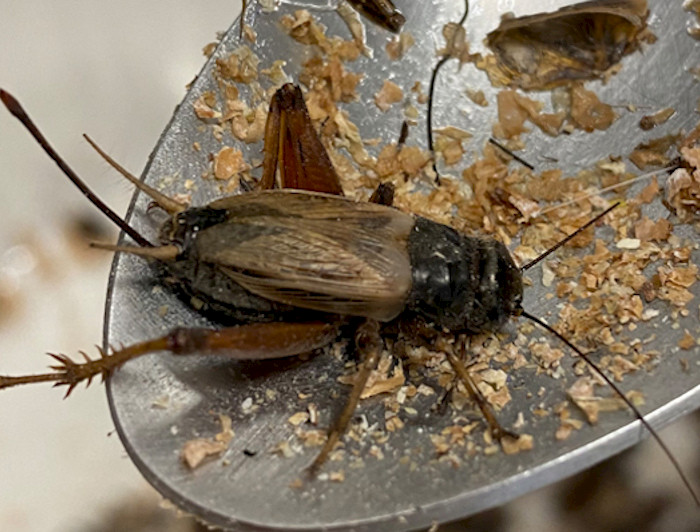Should we eat bugs? UC Chile researchers develop cricket food
During the pick of the pandemic, the UC Chile Nutrition and Dietetics Program tested products made with bugs to determine acceptability and feeling of fullness. This year, they will test the products on consumers, specifically high-performance athletes.

photo_camera Researchers from Nutrition and Dietetics evaluated the nutritional and human tolerance of pizzas and energy bars using Chilean crickets. (Credit: UC Chile Nutrition and Dietetics Program)
Not even the pandemic was able to stop the efforts of the UC Chile Nutrition and Dietetics research program.
So, between 2020 and 2021, academics and students carried out a project to assess the human tolerance and nutritional variables of Chilean cricket-based pizzas and energy bars. The objective was to advance the analysis of entomophagy or insect-based foods as a sustainable food alternative for Chile.
Entomophagy (the technical term for eating insects) is a common practice in several parts of the world, such as Asia, Africa and Central America, where there is less cultural resistance toward human consumption of insects.
Larvae, crickets and beetles are among the five varieties most consumed by humans, although in Chile, we are at an infancy stage.
Sebastián Tobar, chef and professor at the Nutrition and Dietetics Program, promotes this alternative food.
In 2018 developed other innovative projects, including empanadas prepared with insect larvae. Then, he moved from using the larvae in his recipes to the 'Chilean cricket' during the pandemic.
Nutritional Value

We now know the meat industry is mainly responsible for greenhouse gas emissions. So, it makes sense for entomophagy to have gained relevance as a more sustainable food alternative.
"In 2020, we decided to work with Chilean crickets, an unknown food source in our country. The crickets get to our laboratory alive, and to comply with the ethical standards of food processes, we would freeze and later fry them to use the raw material then. We compared pizzas prepared with shredded meat versus whole fried crickets on melted cheese. The products were tested by a sample of 60 volunteers, evaluating flavor and reaction to appearance," explained Tobar.
The amount of protein was established at the laboratories of the Institute of Nutrition and Food Technology (INTA, as per its Spanish acronym) to determine cricket's nutritional value.
In the case of pizzas (one prepared with meat and the other with crickets), both products were well received, although the volunteers preferred the meat pizza as the other had the whole crickets on top. Also, both products contained the same protein level per serving.
In 2021, UC Nutrition and Dietetics area developed a second project to create energy bars made from Chilean cricket, with the support of Giovanna Valentino, nutritionist and professor at UC Chile.
The product was well-received by a sample of 36 consumers who did not know its ingredients before trying it.
"We carried out a pilot study with undergraduate students. The results showed no difference regarding satiety when comparing milk protein bars with cricket bars. Both also have a similar nutritional composition. We also used a visual analogue scale for the study," Valentino explained.
"Likewise, an experimental study published in the American Journal of Clinical Nutrition showed similar effects on intestinal absorption and muscle protein synthesis when comparing insect versus dairy protein intake. More studies and evidence are still needed to make specific recommendations. However, everything points to the fact that insects as a protein source have good nutritional value and are sustainable for human consumption, given their lower water and carbon footprint," Valentino added.
One of the most exciting results from the study was that the cricket bar registered good fullness levels within 60 minutes after ingestion. In terms of taste, users did not perceive significant differences.
"During 2022, we intend to conduct new product taste tests with high-performance athletes. They are consumers who are used to this format and will evaluate taste, feeling of fullness and appearance. We are interested in their opinion because they are consumers who are more sensitive to differences," Tobar explained.
Both projects were funded by the UC Nutrition and Dietetics Program budget.


